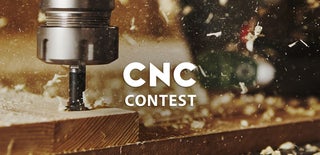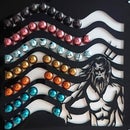Introduction: Turn Your Friend Into a Laser-cut Statue
In this Instructable, I'll guide you through the process of turning one of your friends into a layered statue. You will need access to a lasercutter or CNC machine, otherwise prepare for the work of the decade.
Credit where it is due: The end result was inspired by thesesculptures by Olivier Duhamel, it's definitely worth checking out his collection.
Apart from access to a lasercutter, you will also need:
- White and black acrylic sheet. Mine is 3mm; I used a single 600x400mm sheet of each color. The statue stands about 50cm tall (without the wood).
- A piece of wood or other pedestal, mine was a leftover from a carport pillar.
- One 3-4 mm iron or steel bar, around 50 cm in length, whatever you can find that is pretty sturdy.
- Some small bamboo sate sticks or other straight sticks/wire.
Total cost of the project, given that the wood was free: +- 20 euro.
I also advise to have some spare cardboard laying around, because you will most certainly want to make some test versions first.
Step 1: Strike a Pose
First of all, you'll need someone to model your statue after. Try out a bunch of different poses and take tons of photos. Once you have a pose that you like, film a 360 view, holding the camera at a steady height. You may want to take some additional photos from different angles as well.
Three things to watch here:
- You'll lose most of the expression in the layers, so try to go for a dynamic pose. You can find inspiration in existing statues, artwork, or a 3D store like this one.
- Don't make life too hard on yourself with crazy twists, these will be hard to model in Blender.
- The whole statue is quite heavy for the relatively thin support structure. Make sure the bulk of the weight can be supported by a steel rod from the base, for example by extending one leg straight down as in the image above.
Step 2: Transfer to Blender, Slice It
I won't go into the details of Blender modelling as there are thousands of great online tutorials on it, such as these. Essentially, you import your images as a background, draw a rough blocky model, and kind of just drag and drop nodes from there until the end result looks somewhat half decent. I found it easiest to work in the basic mode, with a rendered subdivision mask visible but not applied yet. Remember that we're not aiming for great facial expressions here - just the basics will do fine. It took me a few days to get it right, having absolutely zero prior experience in the program. This project was intended to be my motivation to start learning it.
I am purposely not attaching my own digital files, because I'd like my friend's image to stay unique. However, if you want to build a version without the whole 3D-modelling hassle, you can easily find similar files for free online, such as on Thingiverse, Free3D, Renderpeople, ... If they have a rigged skeleton, you can even adjust the pose.
As soon as you have a first draft, you'll want to slice it. For this I used this python script right here. It's very easy to install and comes with a tutorial video (not written by me). The end result will be a 2D SVG file, which you can open with any vector program such as Inkscape. Before taking it out of the lasercutter, tape down the pieces - there are a LOT of pieces! You could also engrave numbers in.
At this point, I made a horribly blocky first version to test the concept, and it worked! My friend was not amused with this representation :)
Step 3: Test Versions & Going Diagonal
It is not always easy to get a good idea of the final shape in a 3D-render, so I made quite a few cardboard versions. Some I only assembled halfway through to focus on a certain part. v2 was way too thin. v3 was a little twisted. v4 was the first version after I decided to go for diagonal layers, and the first one I really loved. v5 is the plastic version on the cover!
That said, when I write "v5 came after v4", I really mean v5 came after v4.3.d.final.sliced.3.edit2.final, of course. Hang in there!
Diagonal layers make the concept stand out more, because larger flat areas are visible this way. The versions with the horizontal layers are a little more average statue. There is way more contrast between the layers in the diagonal version; a difference that will be even more apparent when the colors of the layers are alternated.
It also decreases the overall amount of layers, which conveniently lowers the assembly time. To slice your model diagonally, simply rotate it a little before running the script.
Step 4: Support Structure
You'll want to add some cylinders the size of your wooden/iron supports to the frame. This makes it a lot easier to place the layers on top of one another. Alignment really is key - just a mm off on a few layers and your entire shape WILL be ruined. The 4mm iron bar that serves as the main support is a good start; but the slices can still rotate around it so it is best to add at least 1 parallel 3mm bamboo stick a cm next to it. You can glue the layers in place when they are aligned, so these don't need to be too sturdy.
If your support structure is not 100% perpendicular to the layers, you'll need to make it a little wider to account for the thickness of the material: If your stick is 3mm wide, and the hole is 3mm wide, you can't insert it diagonally. In my cardboard versions this was never a problem (it gives a little). However, in the plastic version, we have to account for the difference in size when placing the supports - you can just make the holes a little wider. Where possible, try to have at least one support stick 100% perpendicular to the layers to ensure proper alignment.
Step 5: Showcase!
Last but not least, transform your statue from a project into a work of art by adding a good-looking base in any different material (wood, concrete, ... ) and by slapping on a fancy laser-engraved nametag.
The 4mm steel rod isn't really visible, but runs from the right shoulder through the left leg, and continues into the base at a slight angle for about 10 cm. Before you drill the hole into the base, make sure your statue will "fall" in the right direction, if the hole is 0.5mm larger than the rod it'll stand up correctly without having to add glue.
Follow me on Instagram to see the occasional project that doesn't end up here. Good luck! Let me know if you make one.

Participated in the
CNC Contest 2020













